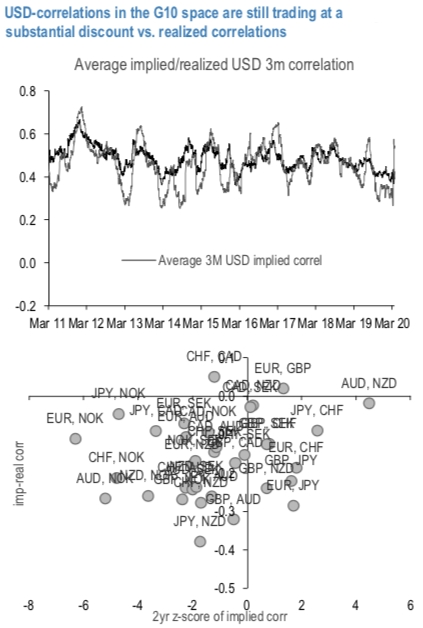One thing which stuns in the FX space is the lack of repricing of USD-implied correlations, at a time when all risk measures are spiking and measures of Equity-implied correlations reached all-time highs in mid-March.
Long USD correlation and skew positions were recommended as a hedge in a piece published this January, ahead of the market carnage that started a few weeks later.
Long USD skews and correlations offer room for playing COVID-19 hedge trades.
We can see that, at least in the G10 space (refer 1st chart) average pricing of 3M USD-implied correlations remained fairly constant over the past month, trading at a 15 corr points discount vs realized correlation, which spiked over the past two weeks as long USD positions were supported in the risk-off correction.
A more granular analysis in the 2yr z-score of implied correlations vs. correlation premium space shows several cases, amongst which NZDJPY, NZDCHF and GBPUSD (in the latter case, implied trails realized by 32 corr points), where current pricing of implied correlations is attractive. Keeping in mind that liquidity of correlation products might be now drier than during normal market conditions, scouting for cheap entry points in the correlation space does not look like an unrealistic task, even at this point in the COVID-19 crisis. One possibility why this might be the case is that, after a rollercoaster ride, the DXY Index is up a mere 1.5% since mid-February, as an indication that its safe haven status might not be fully trusted by investors.
We recall readers that the simplest way for estimating implied correlations is via a trigonometric identity involving ATM volatilities, as for instance displayed in the charts above. The actual pricing of correlation products, like corr swap, dual-digis, best/worst-of is in addition also sensitive to vol smiles. In the two following charts, we display a simplified case study (refer 2nd chart), for USDJPY vs EURUSD and GBPUSD, where we consider three strikes for each pair (corresponding to 3M ATMF and +/- 25-delta), and compute the implied correlation based on the cross-vol for the equivalent strike (as an example, for EURUSD K1 = 1.0927, USDJPY K2 = 103.88, EURJPY K1,2 = K1 * K2 = 113.51 level).
The resulting correlation surfaces display a marked strike- sensitivity (i.e., they do depend on the skew), as an indication that, for both buyers and sellers of correlation, the choice of the strike, as in dual-digi structures, can be optimized for reaching a desired correlation benefit. In the two cases below, however, the level of the correlation remains negative for all strikes considered, even the one where USD moves in opposite direction vs. the two other currencies (i.e., EURUSD and USDJPY down). After re- expressing the above in terms of USD as a common asset currency for both pairs, USD correlations are then always positive. Courtesy: JPM



 Impact of Iran-Israel conflict on Stocks, Gold and Bitcoin
Impact of Iran-Israel conflict on Stocks, Gold and Bitcoin  Core- Bitcoin Layer 1 Blockchain with Satoshi plus novel consensus mechanism
Core- Bitcoin Layer 1 Blockchain with Satoshi plus novel consensus mechanism  FxWirePro- Gold Daily Outlook
FxWirePro- Gold Daily Outlook  FxWirePro- Gold Dailty Outlook
FxWirePro- Gold Dailty Outlook  FxWirePro- Gold Daily Outlook
FxWirePro- Gold Daily Outlook  FxWirePro- Gold Daily Outlook
FxWirePro- Gold Daily Outlook 































